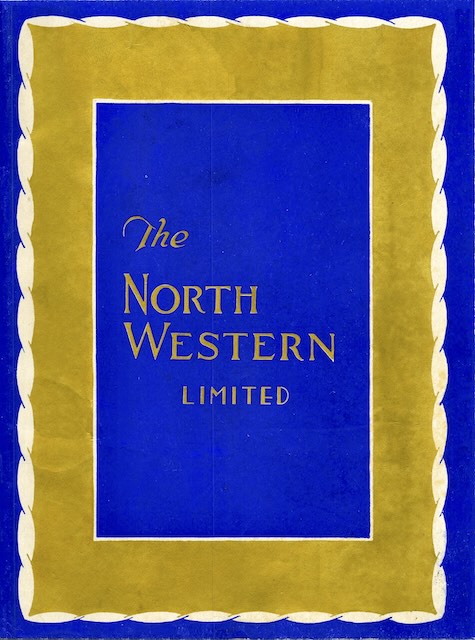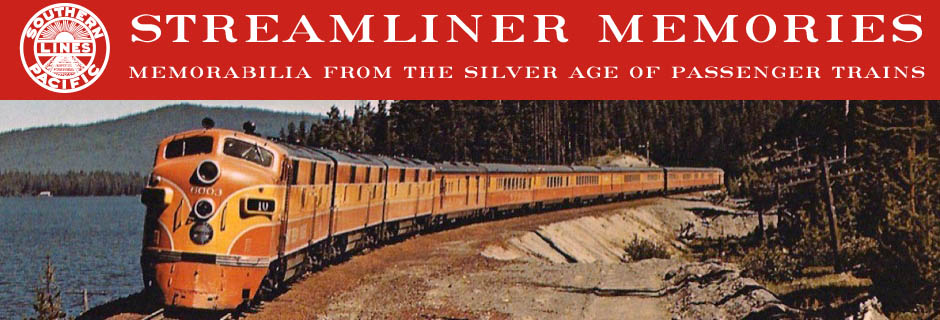The North Western Limited was for many years the Chicago & North Western’s premiere overnight train that ran entirely over its own rails. It was completely re-equipped in 1928 and the 16 crisp black-and-white photos in this 1929 booklet show that the new train was one of the finest in the country.
 Click image to download a 5.9-MB PDF of this 28-page booklet.
Click image to download a 5.9-MB PDF of this 28-page booklet.
The North Western Limited began operating sometime before 1900. According to Wikipedia it started in 1914, but that’s wrong because Official Railway Guides mention it long before that. As I’ve previously noted, in the Official Guides the train was simply called a “vestibuled limited” until October 1892, when the name North Western Limited first appeared.
The genesis of the train went back to 1882 when the C&NW purchased control of the Chicago, St. Paul, Minneapolis & Omaha Railway, giving it a shorter route to the Twin Cities from Chicago. The two railways continued to operate separately for years, with the CStPM&O designating the North Western Limited trains 5 & 6 while the C&NW called them trains 405 and 406. It and other Chicago-Twin Cities trains went over the C&NW from Chicago to Elroy, Wisconsin and over the CStPM&O from Elroy to St. Paul.
In 1892, the train took about 14 hours between Chicago and the Twin Cities. By 1926, this had been cut by one hour. The train didn’t have an observation car as it operated mostly at night but it did have a “lounging car.” It had a diner only on the portion between Chicago and Milwaukee.
The 1928 equipment described in this booklet was a significant improvement as the new train had both an observation car and a diner operating through to Minneapolis. The observation car had larger-than-normal windows in an eight-seat solarium lounge (see photo on page 7). Another 14 seats were in the observation parlor, which had normal-sized windows (pages 9 & 11). In addition to a four-seat women’s lounge (page 10), the car also had six bedrooms designed for one person each (page 12), though two could fit if they were friendly.
The truly impressive addition to the train was a full-length lounge car, which had about 38 seats divided among three separate rooms with luncheonette and fountain service. These rooms are illustrated on pages 16, 17, 18, and 19, while the more conventional dining car is shown on pages 14 and 15.
In addition to standard sleeping cars that were dominated by sections (shown on page 13), the North Western Limited carried one all-compartment car with three drawing rooms (providing three beds and private bathroom) and six compartments (two beds each with toilet and sink) for a total of 21 beds. A drawing room and compartment are awkwardly shown in a photo on page 21 that makes them look more cramped than they really were. Since the standard sleepers had as many as 28 berths whose occupants had to share baths, the all-compartment car was the height of luxury in 1928.
The new train also went a little faster, making the trip from Chicago to Minneapolis in 11-1/2 hours and from Minneapolis to Chicago in just over 10-1/2 hours. The North Western Limited‘s daylight counterpart was the Viking, which took just under 11 hours in both directions. This train was equipped with an observation-parlor car, diner, and coaches. The observation car had one drawing room in it for those who could afford to demand privacy.
C&NW had other trains between Chicago and the Twin Cities in 1929. The North American was an overnight train that left Chicago a couple of hours after the North Western Limited but left Minneapolis a couple of hours before. It came with a diner and observation-lounge car and some of its cars split at Milwaukee to go to Duluth while other cars went to Rochester. The North Western Mail and Badger State Express went via Madison rather than Milwaukee, but these made many more stops and required 13 to 15 hours between Chicago and Minneapolis.
